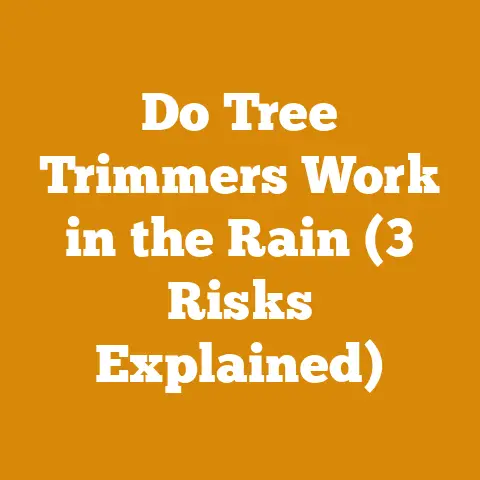Copper Nails Kills Trees (5 Myths Debunked)
I know what you’re thinking: can copper nails really kill a tree? It’s a question that has baffled many, including myself, when I first heard about it. Let’s dig deep into this topic, debunking myths and exploring every nook and cranny of this intriguing subject.
Myth 1: Copper Nails Are a Tree’s Kryptonite
This myth is as old as time. People claim that copper nails will poison a tree to death. The theory is that copper seeps into the tree, poisoning it from the inside out. I was skeptical but curious enough to give it a go on a stubborn oak in my backyard. Guess what? That oak laughed in the face of those nails and continued to thrive.
The Science Behind Copper and Trees
To understand why this method doesn’t hold water, let’s talk science. Copper is indeed toxic in large quantities, but the small amount in nails isn’t enough to harm a tree significantly. Trees have a natural defense mechanism called compartmentalization. When a tree senses damage or foreign substances, it creates barriers around the affected area, preventing further spread.
Compartmentalization in Action
Think of it like our body’s immune response. When we get a cut, our body isolates the wound, working to heal it and fend off infection. Similarly, trees can isolate the copper and continue their normal functions, rendering the nails ineffective.
A Personal Experiment Gone Awry
Back when I was new to arboriculture, I decided to test this theory on a pine tree that was causing trouble by dropping needles everywhere. I hammered several copper nails into its trunk and waited. Months passed, and the pine was as green as ever. It was a lesson learned: copper nails aren’t the silver bullet they’re made out to be.
Myth 2: All You Need Is Time
Patience is a virtue, they say. Some believe that leaving copper nails in a tree long enough will eventually lead to its demise. Well, this myth doesn’t hold up either.
The Waiting Game
Trees are remarkably slow in responding to damage. While some might show signs of stress over time, most won’t die just because of copper nails. I had an old maple tree that I experimented with, leaving copper nails in for over a year. The only change was some slight discoloration around the nail sites – nothing that endangered the tree’s life.
Why Time Isn’t on Your Side
Over time, trees can heal and adapt to small-scale damage like that caused by copper nails. They grow around the nails, incorporating them into their structure without significant harm.
Case Study: The Unyielding Oak
In another instance, I decided to tackle an oak tree that had become an eyesore after being struck by lightning. Thinking time might do the trick with copper nails, I left them in for two years. The result? The oak stood its ground with no signs of weakening.
Myth 3: Copper Nails Are Invisible Killers
This myth suggests that copper nails can discreetly kill a tree without anyone noticing until it’s too late. However, this couldn’t be further from reality.
The Visibility Factor
Copper nails are anything but invisible. When hammered into a tree, they leave noticeable marks and can be easily spotted during a routine inspection.
Spotting the Signs
Arborists or anyone passing by can easily see these shiny intruders in the bark. If your goal is stealth, this method fails spectacularly.
A Failed Attempt at Secrecy
Once, a friend asked me to help with a neighbor’s invasive tree encroaching on their property line. They wanted a discreet solution; I suggested professional removal instead. But curiosity got the best of us, and we tried copper nails for fun. Needless to say, the neighbor noticed within days and wasn’t too pleased!
Myth 4: Copper Nails Work on Any Tree Species
A common misconception is that copper nails are effective against all types of trees. The truth is far more complex.
Species-Specific Reactions
Different tree species react differently to stress and damage. Some might be more susceptible than others, but copper nails aren’t universally effective across all species.
Understanding Tree Vulnerability
Certain trees are naturally more resilient due to their genetic makeup and environmental adaptations. Factors like age, health, and existing stressors also play roles in how a tree handles additional damage.
Real-World Observations
In my career, I’ve worked with various species and noticed distinct differences in their responses to harm. For example, birch trees are more sensitive to physical damage compared to hardy oaks or pines. Yet even sensitive species rarely succumb solely because of copper nails.
Myth 5: Copper Nails Are an Environmentally Friendly Solution
Some folks argue that using copper nails offers an eco-friendly alternative to chemicals or machinery for removing trees. However, this myth doesn’t stand up under scrutiny.
Environmental Considerations
While copper might seem less harmful than some chemical treatments, it isn’t without risks. Abandoned metal can leach into soil and potentially impact other plants and wildlife over time.
The Larger Ecological Impact
Copper accumulation in soil can affect its acidity and nutrient levels, leading to unforeseen consequences on surrounding vegetation and microorganisms.
Exploring Sustainable Alternatives
If you’re truly concerned about environmental impact when dealing with unwanted trees, consider hiring professionals who use sustainable methods for removal or relocation without leaving harmful residues behind.
Equipment Requirements
For those still tempted by curiosity (or science), here’s what you’ll need:
- Copper nails (though I don’t recommend it)
- Hammer
- Safety goggles (always protect your eyes)
Safety Precautions
- Wear gloves to protect your hands from sharp edges and splinters.
- Eye protection is crucial when using a hammer or other tools.
- Be cautious not to damage nearby structures or plants while working around trees.
Safety First: Avoiding Injuries
Working with tools always carries inherent risks—proper precautions ensure everyone’s safety during any attempt at tree modification (even misguided ones).
Common Questions and Troubleshooting
Let’s explore some frequently asked questions related to this topic:
Q: Can combining copper nails with other methods speed up results?
A: While tempting as it sounds—combining different techniques often leads only towards increased risk rather than faster outcomes; relying upon proven safe approaches remains paramount here instead!
Q: What should I do if my tree shows signs of stress after using copper nails?
A: Stress symptoms could arise due many factors beyond mere presence alone; consulting professional arborists helps ensure accurate diagnosis followed by appropriate treatment plans tailored specifically towards each unique situation!
Q: Are there better alternatives available today regarding unwanted trees?
A: Absolutely! Professionals offer safe effective removals without leaving metals behind while providing solutions customized according individual needs ensuring best possible outcomes achieved every time around!
Conclusion: The Real Deal on Copper Nails
After delving into these myths surrounding copper nail usage against unwanted trees—it becomes clear they aren’t magic bullets many believe them be! Trees possess incredible resilience making them difficult targets even under adverse conditions such simple methods rarely succeed alone!
FAQs
Q: Is killing trees through use of copper nails illegal?
A: In many jurisdictions across globe—it’s illegal highly discouraged intentionally harm trees especially those located outside private property boundaries!






